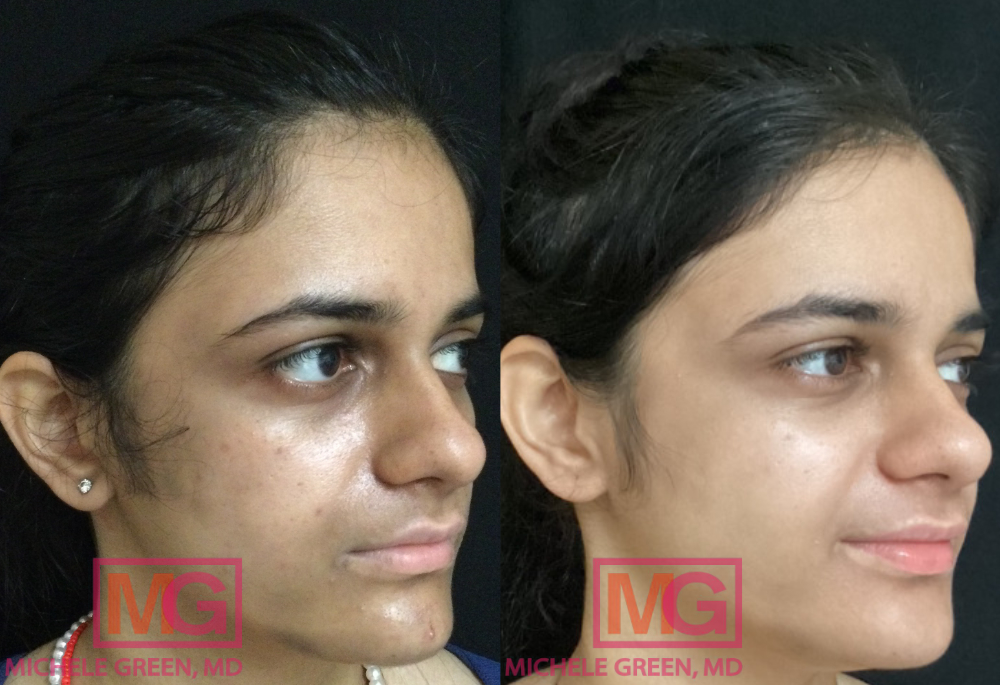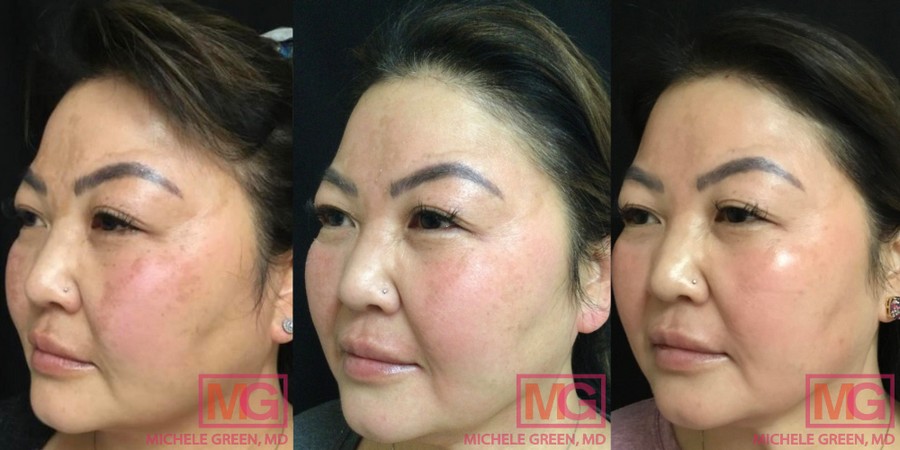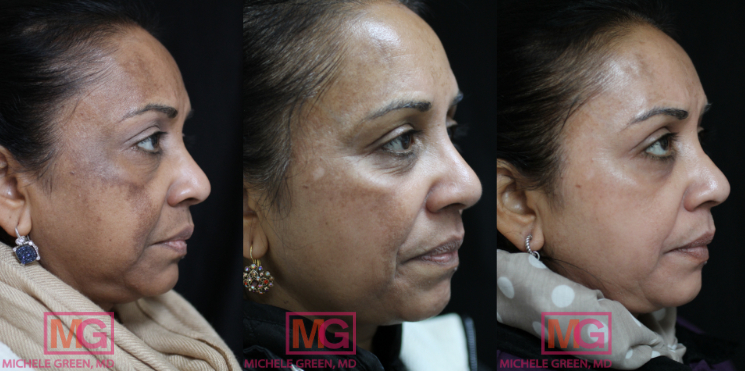Best Sunscreen for Melasma
Melasma is a skin condition characterized by uneven brown or gray patches appearing on the skin’s surface. While the exact cause of the condition is not yet known, studies have shown that sun damage and unprotected exposure to UVA and UVB rays of light considerably worsen the discoloration associated with melasma. Melasma tends to affect patients with darker skin tones at a higher rate than patients with lighter skin tones due to the higher concentrations of melanin and the activity of melanocytes in darker skin. UV rays and sun exposure are responsible for many signs of aging, including the formation of age spots — also known as sunspots or dark spots — the worsening of wrinkles, and the exacerbation of skin conditions, such as melasma, post-inflammatory hyperpigmentation, and rosacea. That is why it is essential to practice strict sun protection to prevent and reduce the incidence of melasma. But many patients wonder, “What is the best sunscreen for melasma?” And the best way to find the answer is to consult with an expert board-certified dermatologist, such as Dr. Michele Green.
With many different types of skin care products and sunscreens available over the counter, it can be hard to know which type of sunscreen is best for preventing a melasma flare-up. The most important thing is that patients stay regimented in their sun protection by including broad-spectrum sunscreen in their daily skincare routine. Every morning following the application of a moisturizer, patients should apply daily sunscreen — ideally one that is labeled as broad-spectrum SPF 50 — and reapply every two hours. For even more protection, patients can pair a chemical sunscreen, which contains ingredients like oxybenzone or avobenzone, with a physical blocker, also known as mineral sunscreen, which contains ingredients like zinc oxide, iron oxide, or titanium dioxide. To find out which sunscreen options and skincare products will best meet your needs, schedule your initial consultation with experienced dermatologist Dr. Michele Green.
Experienced board-certified dermatologist Dr. Michele Green has been masterfully treating patients in her Upper East Side New York City dermatology office for more than 25 years. With her proprietary range of skincare products, MGSKINLABs, Dr. Green is an expert in providing patients with individualized treatment plans tailored to their skin type and aesthetic goals. Whether you are concerned about sensitive skin, hyperpigmentation, dark spots, melasma, or signs of the natural aging process, Dr. Green has plenty of treatment options available. In addition to generating individualized skincare plans, Dr. Green has a range of in-office treatments that can help with melasma management and treatment, including chemical peels, mesopeels, microneedling, microdermabrasion, and Cosmelan peels. Well-known for high patient satisfaction, Dr. Green has been voted one of the best dermatologists in New York City by such publications as Castle Connolly, Super Doctors, and New York Magazine.
What is Melasma?
Melasma is a skin condition characterized by the formation of uneven patches of discoloration — often brown or gray — on the skin’s surface. The discoloration that appears is darker in tint than the rest of the skin. Three main types of melasma exist: epidermal melasma, which is when pigmentation appears on the outer layer of the skin; dermal melasma, which is when the pigmentation is located in the middle layer of the skin (known as the dermal layer); and mixed melasma, which is when the pigmentation is present both in the middle and outer layers of skin. Most commonly, the areas that are affected by melasma include the upper lip, cheeks, forehead, and bridge of the nose. Since these areas are highly visible, many patients with melasma feel self-conscious about the discoloration, causing them to seek out the underlying cause of the condition, as well as prevention and treatment options.
Melasma occurs when the pigment melanin is overproduced in the melanocytes, which are responsible for producing melanin. When melanin is overproduced, it causes uneven pigmentation across the skin’s surface, resulting in uneven dark patches. The exact cause of the skin condition is not yet known. However, several major risk factors increase the likelihood of developing melasma:
Sun exposure is a significant factor in the development and worsening of melasma. The sun emits several forms of light that can contribute to the condition, including UVA and UVB rays and visible light, such as blue light. Without UVA and UVB protection, these rays of light trigger the overproduction of melanin in the skin, exacerbating melasma and darkening the patches of pigmentation. In fact, sun exposure is the most common trigger for breakouts of melasma, becoming especially prevalent in summer months when patients spend more time in the sun. Understanding the role of sun exposure in melasma can empower you to take the necessary steps to protect your skin and prevent flare-ups.
Skin Tone: Patients with darker skin tones — III-VI on the Fitzpatrick scale — are more likely to experience melasma, as there are more active melanocytes present in the skin. Many patients of color do not experience sunburn and, for that reason, do not wear sunscreen. However, sunscreen is very important for skin of color to prevent melasma breakouts.
Hormone fluctuations: High levels of the hormone estrogen can also contribute to melasma flare-ups. Melasma is particularly common in pregnant people—so much so that the skin condition is often referred to as the “Mask of Pregnancy.” However, it is much less common in patients assigned male at birth, as, according to the American Academy of Dermatology, only 10% of melasma patients are male.

Dermatologist-recommended skincare for hyperpigmentation and melasma treatment
Melasma cannot be cured, but there are many treatment options to help manage melasma flare-ups and other forms of hyperpigmentation, such as post-inflammatory hyperpigmentation (PIH). The best way to manage the skin condition is to prevent flare-ups by reducing exposure to known triggers, such as sun exposure. To do so, Dr. Green recommends the use of a broad-spectrum SPF 50 sunscreen applied every morning and reapplied throughout the day, especially when spending significant time outside. Some medications can also cause flare-ups to occur, so Dr. Green recommends speaking with your primary care provider to try other medications if that is the case.
When experiencing a melasma flare-up, Dr. Green recommends a combination of skin care products and in-office treatments to reduce the symptoms:
Topical Skin-Lightening Products
- Hydroquinone: a topical cream that can be prescribed to help lighten areas of hyperpigmentation
- Tretinoin (Retin-A): a topical retinoid for skin lightening
- Vitamin-C serum: a powerful antioxidant to address areas of pigmentation
Chemical Peels can be performed in-office to improve skin tone and texture without the need for significant downtime or the risk of serious side effects. They work by applying a topical chemical solution that reacts with the dead skin cells and debris on the skin’s surface, causing them to slough off and boosting skin cell turnover for clearer, brighter, lighter skin. Dr. Green is an expert in many different types of chemical peels, which have a range of active ingredients to address various skin concerns but will often turn to the TCA peel for melasma.
Cosmelan Peel: A professional-grade mask applied in-office, the Cosmelan Peel is often Dr. Green’s go-to for melasma treatment. Based on the severity of the pigmentation, skin tone, and skin type, Dr. Green will determine the amount of time needed for the peel to stay on the patient’s face. Patients can then wipe away the mask at home using a gentle cleanser. The resulting skin peeling will help provide patients with smoother, clearer, brighter skin and reduce the appearance of melasma.

Does sunscreen help melasma?
Wearing sunscreen is perhaps the most important step in managing melasma, as sunscreen can help prevent melasma flare-ups and reduce the severity of the condition. Dr. Green highly recommends that patients add sunscreen application to their daily skincare routine. In the morning, patients should wash their face with a gentle cleanser, apply a light, hydrating moisturizer, and then a broad-spectrum SPF 50 sunscreen. Even when you are inside, UVA rays can still filter through some windows and cause melasma to flare up, which is why it is imperative to wear sunscreen every day. When patients do spend significant time outside, Dr. Green suggests reapplying sunscreen every two hours to ensure full UVA and UVB protection.
Can sunscreen prevent melasma?
Patients will sometimes ask, “Does sunscreen prevent melasma?” The answer is yes — sunscreen can help prevent melasma flare-ups. In a study done in Morocco, researchers found that pregnant women who wore a broad-spectrum SPF 50 sunscreen and reapplied it every two hours experienced fewer incidences of melasma. Out of the 185 women who participated in the study, only 5 (2.7%) experienced new melasma cases in the 12 months during and after their pregnancy, compared with a 53% incidence in the general population. As such, it is essential to practice strict sun protection by wearing sunscreen every day and reapplying whenever you are outside for an extended period to prevent incidences of melasma and manage the condition.
Can sunscreen remove melasma?
Sun exposure is one of the most common triggers for melasma cases and flare-ups, which is why strict sun protection is so important. Additionally, regular use of sunscreen can provide patients with the greatest chance of reducing the severity of the pigmentation associated with melasma. One study on the impact of sunscreen use on melasma found that patients with existing melasma breakouts experienced a reduction in symptoms when they used broad-spectrum SPF 50 sunscreen daily.
What sunscreen to use for melasma
There are two overarching types of sunscreen available: chemical sunscreen, which contains active ingredients such as oxybenzone, avobenzone, and cinnamates to protect against UVA and UVA rays, and physical sunscreen, which contains active ingredients such as zinc oxide, titanium dioxide, and iron oxide to create a physical blocker of UVA and UVB rays. Dr. Green recommends the use of both a chemical and a physical sunscreen for the best sun protection results. It is wise for patients to choose a sunscreen that is SPF 50 or higher for better protection against the sun. Additionally, sunscreens that block visible light, as well as UV rays, can further protect the skin and reduce the risk of melasma flare-ups. For more complete coverage, Dr. Green suggests using lotion sunscreen rather than aerosols or spray-on sunscreen. While aerosols are convenient, they often provide less protection than lotion.

What is the best sunscreen for melasma?
Patients often wonder, “Which sunscreen is best for melasma?” The answer is that it is essential to find a sunscreen option that you like so that you are motivated to wear it every day. The best sunscreen routine typically uses a combination approach of chemical sunscreen and mineral sunscreen for more complete coverage. When it comes to choosing a brand of sunscreen that will be effective for managing the symptoms of melasma, Dr. Green recommends the following:
- MGSKINLABs Essential Moisturizing Sunscreen SPF 50 – a mineral sunscreen containing hydrating ingredients
- La Roche-Posay Anthelios Broad-Spectrum SPF 100
- EltaMD UV Clear Face Sunscreen with Zinc Oxide
- CeraVe 100% Mineral Sunscreen with Niacinamide
- EltaMD Tinted Mineral Sunscreen
To find out more about which option is the best for your skin type and skin tone, schedule a consultation appointment with Dr. Michele Green.
Why is tinted sunscreen better for melasma?
When patients ask, “Why tinted sunscreen for melasma?” the answer is that tinted sunscreen helps to block blue light, which is also known as HEV, which is a visible light that can exacerbate symptoms of melasma. Tinted sunscreen, which gets its tint from iron oxide contained in the solution, is a good option to add to the arsenal of sunscreen options for full sun protection. In a study done by Mahmoud et al., researchers demonstrated that the use of sunscreen that protects against UV rays combined with sunscreen that protects against visible light provides a significant reduction in melasma symptoms. 75% of patients who used both forms of sun protection (UV protection and visible light protection) experienced a reduction in melasma symptoms compared to 60% of patients who used just UV protection.
Is chemical sunscreen bad for melasma?
Chemical sunscreen is absorbed into the skin when it is applied. It can absorb UV rays and convert them to heat, protecting the skin from harm. Dr. Green often recommends combining chemical sunscreens with physical blockers, such as mineral sunscreens, for more complete coverage. Chemical sunscreens are not bad for melasma, nor are they ineffective at providing protection.
Why is mineral sunscreen better for melasma?
Mineral sunscreen, also known as physical sunscreen, works by creating a physical barrier between the sun’s UV rays and the skin with active ingredients, such as zinc oxide, titanium dioxide, and iron oxide. The UV rays are reflected off of the physical blocker, thereby protecting the skin. Some patients are reluctant to use mineral sunscreen as some physical blockers leave a white cast after application, meaning that they do not absorb into the skin and rather appear white on the skin’s surface. Patients concerned about a white cast for mineral sunscreen may prefer a tinted sunscreen option.
Is Sunscreen SPF 50 better than Sunscreen SPF 30?
The SPF number on sunscreen refers to the amount of time it takes for UV rays to cause sun damage to your skin as compared to having no protection at all. For example, if you wear SPF 30 sunscreen, it would take 30 times longer for sun damage to occur than if you were not wearing any sunscreen at all. However, it is important to note that this rating for sunscreen is determined in lab conditions when the sunscreen is applied exactly as intended. For patients with melasma, Dr. Green recommends using a broad-spectrum sunscreen of SPF 50 or higher. While SPF 30 is generally sufficient for the general population, SPF 50 sunscreen offers that much more protection for patients with melasma, further decreasing the risk of flare-ups.
What is La Roche-Posay sunscreen?
La Roche-Posay is a brand of sunscreen often recommended for patients with melasma. The company offers a wide range of sunscreen options, from chemical sunscreens to mineral sunscreens and even oil-free options for the face. There are also La Roche-Posay tinted sunscreen options with the active ingredient titanium dioxide.
What type of sunscreen is best for melasma?
When it comes to choosing the type of sunscreen that is best for your melasma, it is best to turn to a broad-spectrum SPF 50 or higher sunscreen. Dr. Green recommends combining the two main types of sunscreen, chemical and mineral sunscreens, for increased protection. To find out what skincare routine, sunscreen, and treatment options are best to treat your melasma, schedule an initial consultation with expert board-certified dermatologist Dr. Michele Green.
Can sunscreen cause melasma?
Sunscreen is an essential part of the prevention and treatment process for melasma and does not cause melasma. Sun exposure is one of the primary risk factors for the development and worsening of melasma, meaning that strict, regimented sun protection is essential to reduce the occurrence of melasma flare-ups. Patients should not be afraid to liberally reapply sunscreen throughout the day, especially when they are spending significant time outside. In fact, Dr. Green recommends that patients reapply every 2 hours.
Will sunscreen stop melasma?
Research has shown that sunscreen is essential in preventing flare-ups of melasma and reducing the prevalence of melasma symptoms. Dr. Green recommends combining both chemical and mineral sunscreens for the best results. First, patients can apply the chemical sunscreen and let it absorb into the skin. Then, patients can apply the mineral sunscreen for more complete coverage. While melasma cannot be cured, the symptoms can be managed and lessened with the use of sunscreen.

How to get started with melasma treatment today
Melasma is a skin condition characterized by uneven brown patches of skin most frequently found on the face, such as above the lip, on the forehead, on the nose, and the cheeks. While the underlying cause of melasma is yet unknown, one of the primary risk factors for triggering the condition is unprotected sun exposure, as the sun’s harmful UVA and UVB rays can trigger the overproduction of melanin in the melanocytes. With melasma so commonly found on the face, a highly visible area of the body, many patients wonder how to reduce the symptoms of the skin condition and prevent flare-ups from occurring. The answer is consistent daily use of sunscreen. With many sunscreen options available, it may be difficult to determine which one is right for your melasma management. That is why patients looking to manage their melasma should start their treatment journey by scheduling a consultation with expert dermatologist Dr. Michele Green.
Dr. Michele Green is an internationally renowned board-certified dermatologist with over two and a half decades of experience providing her patients with the best non-invasive treatment options. Dr. Green takes a holistic approach and embraces a less-is-more philosophy, creating customized skincare routines and treatment plans that cater to the unique concerns and aesthetic goals of her patients. She is consistently identified as one of New York’s best dermatologists by Castle Connolly, New York Magazine, and Super Doctors for her dedication to her patients and expertise. Please call us at 212-535-3088 or email our New York City-based office today to schedule a consultation with Dr. Michele Green and determine the best skincare routine and melasma treatment that is right for you.
 212-535-3088
212-535-3088